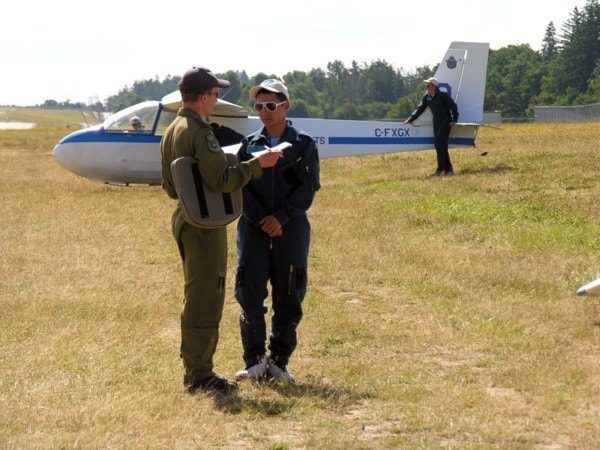I checked in at 7:45 a.m., but by that time the air cadets at CFB Comox had breakfasted and started their daily ground schooling session.
After touring the facilities and chatting with staff at the Pacific branch of the Regional Gliding School, I joined in a session of 'Around the Pole' where cadets were flying model airplanes constructed from balsa wood.
The planes were attached by wire to a cable. Two at a time would fly around the pole until one, or both, crashed. When the opportunity presented itself, one of the fliers would dive bomb his or her adversary.
I tried — unsuccessfully — to dive bomb my opponent while operating a plane specially constructed for the Comox Valley Record. The wheels fell off on the first go but were reattached in relatively short time thanks to a bit of adhesive that resembled Krazy Glue.
Aside from having some fun, the exercise is intended to foster an understanding of basic aviation principles.
After lunch, I attended a pre-flight briefing with staff members before heading to the airfield, where cadets engaged in glider flight training for the rest of their day.
I received a detailed description of the panel inside a cabin before chipping in on a glider launch. Actually I did very little from my position at the rear of the plane. When the rope tightened, the tow plane had snatched the glider from my hands before I was out of the blocks.
My 'work' complete, it was time to fly. I took my place in the tow plane beside Lt.-Col./CO Tony Appels, who took me on four flights with glider in tow. We followed a different route each time, a deliberate practice to minimize the noise impact on residents neighbouring the base.
Once reaching a pre-determined height, the glider is released and veers off on its own, gracefully slicing through the air before landing. When it comes to a stop, a group of eager cadets dash across the runway to retrieve the aircraft.
I leave the premises at 3 p.m., but the cadets continue training at the airfield until about 7 p.m.
On this particular day, 16-year-old Christopher Eckert of Parksville beams with pride after completing his first solo flight. He is among 43 glider course cadets attending the six-week program that demands 10 to 12 hours a day, six days a week from cadets.
Small wonder it's lights out at 9:30 p.m. in the barracks.
Sundays are a day of rest for cadets, who are allowed to venture off-base chaperoned, with the consent of parents.
"For people who want to go into a career in aviation, this is a great start," Appels said.
About 2,100 glider familiarization flights will have been completed by program's end.
The Air Cadet summer program provides an opportunity to receive training that will enhance skills developed at the squadron level. Upwards of 3,600 youths are involved with Air Cadets in 52 squadrons around B.C. Cadets' ages range from 12 to 18 years.
"It's a seven-year career in their life," said Maj. Wayne Heal, noting even two years of training "will change the rest of their life somehow."
The program is a partnership between the Canadian Forces and the Air Cadet League of Canada.
reporter@comoxvalleyrecord.com
